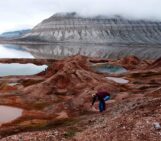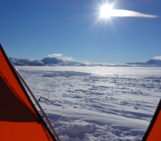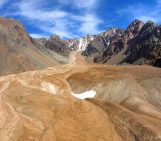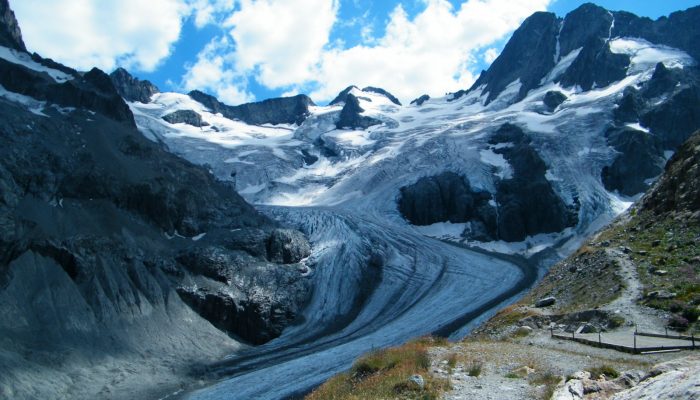
The relentless retreat of glaciers, globally, is widely studied and reported. The causes for the loss of these precious landforms are complex and the dynamics which govern them difficult to unravel. So are the consequences and impacts of reduced glacial extent atop the world’s high peaks, as Alexis Merlaud, explains in this week’s edition of Imaggeo on Mondays.
This picture was taken on 20 August 2009 at the Pilatte Hutt (44.87° N, 6.33° E, 2572 m.a.s.l.), located in the massif des Ecrins in the French Alps. It shows the Pilatte Glacier, which was recently described as being 2.64km2 wide and 2.6 km long.
As most of the glaciers in the world, the Pilatte Glacier has been retreating over the last decades as can be seen from the two pictures in figure 1, taken respectively in 1921 and 2003, and from quantitative measurements since the 19th century. The glacier has lost 1.8 km since the end of the Little Ice Age (1850).
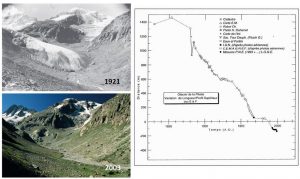
Figure 1: Retreat of the Pilatte Glacier over the last decades (pictures adapted from Bonet et al, 2005, time series from Reynaud and Vincent, 2000).
Two climatic variables affect glacier extents in opposite directions: the amount of winter precipitations (which accumulates snow converting to ice on the glacier) and the summer temperatures (which determines the melting altitude and thus the glacier ablation area – the zone where ice is lost from the glacier, commonly via melting).
The initial retreat of the Alpine glaciers in the 19th century can’t be explained by summer temperatures which remained stable until the 20th century. It has thus been explained by a reduction in snowfall . On the other hand, a recent study suggests that industrial black carbon could have triggered the end of the little ice age in Europe, by reducing the glaciers’albedo. But the globally observed glacier retreat from the 20th century is attributed to the increasing summer temperatures.
Understanding the relationship between glacier dynamics and climate enables to use glacier extents as proxies to reconstruct global temperature time series, as was done by Oerlemans (2005). Using 169 glacier across the globe, this study provided independent evidences on the timing and magnitude of the warming, that are useful to corroborate other time series obtained through other proxies (such as tree rings) or by direct temperature measurements (see Figure. 2), all showing a temperature increase by around 0.5K across the 20th century.
Glaciers continued to retreat in the 20th century, at an accelerating rate. In the 2015 foreword of the Bulletin of the World Glacier Monitoring Service, its director Michael Zemp writes: “The record ice loss of the 20thcentury, observed in 1998, was exceeded in 2003, 2006, 2011, 2013, and probably again in 2014 (based on the ‘reference’ glacier sample)”. Using climate models, it appears now possible to distinguish an increasing anthropogenic signature in this phenomenon.
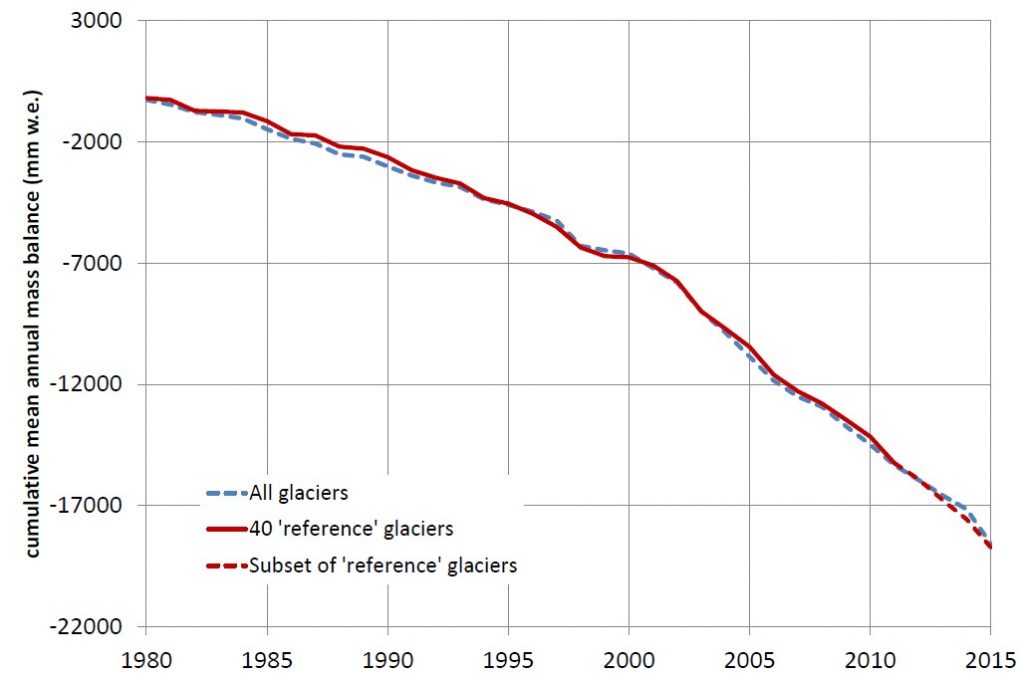
Figure 3: Average glacier retreat worldwide from 1980 in mm of water equivalent (mm.w.e), a unit representing the average thickness of a glacier (WGMS website)
One of the many problems caused by glaciers depletion is the impact on water supplies: glaciers are huge reservoirs of fresh water and their vanishings affect drinking water stock and irrigation for the neighboring population. In the Alps, the idea of replacing the glaciers by dams is already studied. This solution would probably be more difficult to implement in other parts of the world, such as in nothern Pakistan, an area covered with over 5000 glaciers, whose melting is already problematic, causing in particular severe floods.
By Alexis Merlaud, Belgian Institute for Space Aeronomy, Brussels, Belgium
References
Bonet, R., Arnaud, F., Bodin, X., Bouche, M., Boulangeat, I., Bourdeau, P., … Thuiller, W. (2015). Indicators of climate: Ecrins National Park participates in long-term monitoring to help determine the effects of climate change. Eco.mont (Journal on Protected Mountain Areas Research), 8(1), 44–52. http://doi.org/10.1553/eco.mont-8-1s44
Ravanel, L., Dubois, L., Fabre, S., Duvillard, P.-A., & Deline, P. (2015). The destabilization of the Pilatte hut (2577 m a.s.l. – Ecrins massif, France), a paraglacial process? EGU General Assembly 2015, Held 12-17 April, 2015 in Vienna, Austria. id.8720, 17.
Reynaud, L., Vincent, C., & Vincent, C. (2000). Relevés de fluctuations sur quelques glaciers des Alpes Françaises. La Houille Blanche, (5), 79–86. http://doi.org/10.1051/lhb/2000052
Pointer, T. H., Flanner, M. G., Kaser, G., Marzeion, B., VanCuren, R. A., & Abdalati, W. (2013). End of the Little Ice Age in the Alps forced by industrial black carbon. Proceedings of the National Academy of Sciences of the United States of America, 110(38), 15216–21. http://doi.org/10.1073/pnas.1302570110
Vincent, C., Le Meur, E., Six, D., & Funk, M. (2005). Solving the paradox of the end of the Little Ice Age in the Alps. Geophysical Research Letters, 32(9), L09706. http://doi.org/10.1029/2005GL022552
Oerlemans, J. (2005). Extracting a climate signal from 169 glacier records. Science (New York, N.Y.), 308(5722), 675–7. http://doi.org/10.1126/science.1107046
Farinotti, D., Pistocchi, A., Huss, M., al, A. A. et, Barnett T P, A. J. C. and L. D. P., Bavay M, L. M. J. T. and L. H., … Zemp M, H. W. H. M. and P. F. (2016). From dwindling ice to headwater lakes: could dams replace glaciers in the European Alps? Environmental Research Letters, 11(5), 054022. http://doi.org/10.1088/1748-9326/11/5/054022
Marzeion, B., Cogley, J. G., Richter, K., Parkes, D., Gregory, J. M., White, N. J., … Adams, W. (2014). Glaciers. Attribution of global glacier mass loss to anthropogenic and natural causes. Science (New York, N.Y.), 345(6199), 919–21. http://doi.org/10.1126/science.1254702
WGMS (2008): Global Glacier Changes: facts and figures. Zemp, M., Roer, I., Kääb, A., Hoelzle, M., Paul, F. and Haeberli, W. (eds.), UNEP, World Glacier Monitoring Service, Zurich, Switzerland: 88 pp
Imaggeo is the EGU’s online open access geosciences image repository. All geoscientists (and others) can submit their photographs and videos to this repository and, since it is open access, these images can be used for free by scientists for their presentations or publications, by educators and the general public, and some images can even be used freely for commercial purposes. Photographers also retain full rights of use, as Imaggeo images are licensed and distributed by the EGU under a Creative Commons licence. Submit your photos at http://imaggeo.egu.eu/upload/



